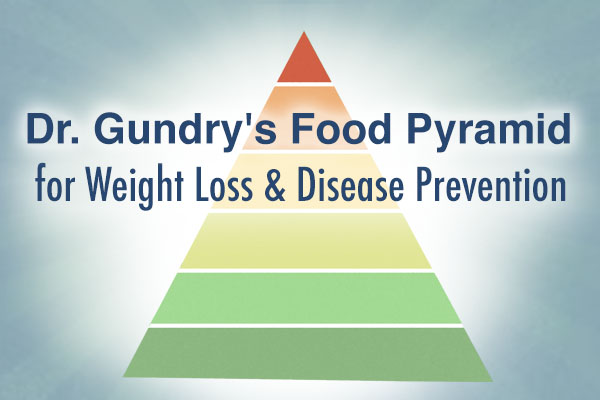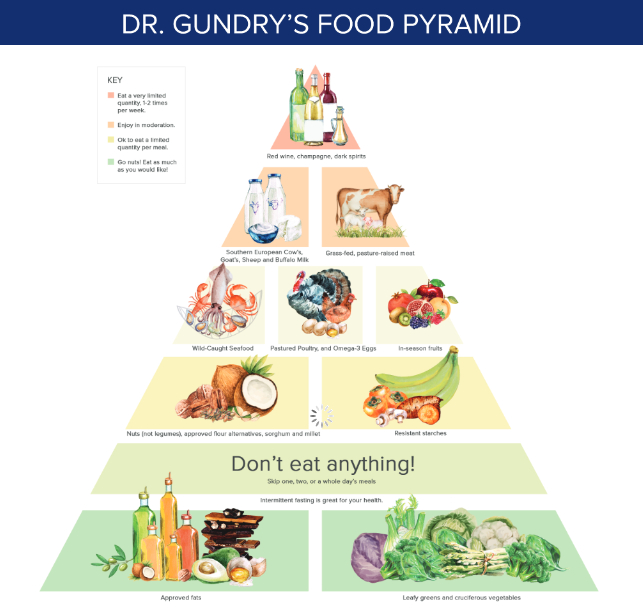
Not too long ago, I received an interesting call from one of my patients asking if I’d see her on short notice.
Turned out, her daughter was supposed to interview someone who had the job she one day hoped to have herself. And this little girl, Keri, wanted to be a doctor.
When I asked Keri why she wanted to be a doctor, she told me she loved making people feel better when they were sick. And she loved healthy food. In fact, she got a 100 percent on her nutrition pop quiz a few weeks back, so she thought she might like to teach people about good food habits.
What happened next blew my mind. She drew a diagram of the USDA food pyramid for me—you know, the one put out by The Department of Health and Human Food Services. And guess what…
It really hasn’t changed since I was in the second grade. Not only that—it’s dead(ly) wrong.
My video below explains why what we were taught in school about nutrition is wrong:
This pyramid tells us to fill up on pasta, cereal, and bread. It just doesn’t work anymore.
I’ve been working with patients for decades. And I’ve heard them share many struggles. For me, so many of their concerns start with a common denominator—grains.
Of course, I’d like to challenge the old model with my own new food pyramid from my new New York Times bestselling book, The Plant Paradox.

Let’s take a look at my new pyramid. We’ll start with the bottom tier, which represents the majority of what you should be eating, and work our way to the top—foods you should only have in strict moderation.
Level 1: Fats, Oils, and Certain Veggies.
These are the most important foods in our diet, and they’re the foods we should be eating the most.
Good fats and oils (like avocados, dark chocolate, and extra virgin olive oil).
Leafy greens (like kale, romaine, and spinach).
Cruciferous vegetables (like broccoli, cauliflower, and Brussels sprouts).
Level 2: Skip a meal.
The second tier of the pyramid introduces the idea of intermittent fasting. Turns out, our ancestors would only be able to eat what they could hunt or find. Food wasn’t always available.
So our bodies adapted to be able to process and store energy based on intermittent periods of having and having not. Our bodies need to go without food from time to time.
Level 3: Nuts, flour alternatives, and lectin-free grains.
It’s okay to eat foods from this category daily. Just make sure to limit consumption of these foods to small portions per meal. And, there are only certain kinds of nuts on the list. Peanuts and cashews should be completely avoided. They’re actually not nuts at all (peanuts are legumes and cashews are seed) and are full of the deadly plant protein called lectins. Instead, stick to macadamia, walnuts, pistachios, Marcona almonds, and pecans.
When it comes to flour alternatives, stick to coconut flour or almond flour. And, there are only two approved grains featured in Tier 3 of the new pyramid:
- Sorghum: Sorghum is an awesome lectin-free, gluten-free flour alternative. And, it’s chock full of fiber. In fact, it’s known to help your heart.1
- Millet: Millet is lectin-free and full of polyphenols that offer more antioxidants than most grains.2
These grains are lectin-free, where most grains are loaded in lectins—especially whole wheat.
Resistant starches:
Resistant starches like green bananas and plantains feed friendly bacteria.
Turns out, there are about 100 trillion bacteria living in each of our guts.3 The good bacteria help our bodies digest, process vitamins, lose weight, and knock out disease-causing pathogens.4 Another reason we want to include resistant starches in our diets is because they can break down fat and reduce fat storage.5 Again, limit the quantity with each meal.
Just remember, while foods like green bananas, green mangoes, and sweet potatoes are great for you, ripe bananas and mangoes are loaded in sugar—to destroy your gut.
Level 4: Certain meats and fruits.
Wild-caught fish:
Now, fish is full of really important nutrients, including protein and vitamin D. But, it’s also a wonderful way to get omega-3 fatty acids, which have numerous benefits, like helping with inflammation.6 Just remember, a serving is 3-4 ounces per day.
Pasture-raised poultry & Omega-3 eggs:
Pasture-raised poultry is not the same thing as free-range or organic. Free-range chickens are never shown the light of day. And, they’re fed corn and soy. Therefore, you are what the thing you ate, ate. Soy and corn are full of toxic lectins and usually a GMO product.
So, there’s only one type of poultry that’s okay here—pasture raised. Omega-3 eggs work because the chickens eat what they’re supposed to eat—bugs and grass, instead of grains—so they don’t fatten you up when you eat them.7
Fruit (but only in season):
Now, it’s okay to enjoy a modest portion of fruit from time to time, but the fruit must be in season.
Turns out, eating fruit in season was a great thing for our ancestors, as it allowed them to fatten up for the winter months. Some fruits are great year round, but they must be eaten while they’re green (underripe). These fruit, eaten green, say in a smoothie, are actually resistant starches:
- Bananas
- Mangoes
- Papayas
And, avocado is always fine, since it’s full of good fat, soluble fiber, and is virtually sugar-free.
Level 5: Approved dairy and meat.
- Southern European cow’s milk, goat’s milk, sheep’s milk, and buffalo milk
We want to stick to the listed types of milk, because they’re the only milks that contain casein A-2 protein. Stay away from casein-A1 at all costs.
Casein A-1 is converted to a protein called beta-casomorphin, which can prompt an immune attack on the pancreas of people who consume milk from these cows, or cheeses made from it.8 This can cause some serious health concerns.
- Grass-fed, pasture-raised red meat
Pasture-raised meats have more omega-3 than animals fed grains and soy. But, we should still be careful not to over-consume them: 3-4 ounces of red meat, once or twice a week, is plenty.
Level 6: Red wine, Champagne, Dark Spirits.
Champagne has been shown to improve memory, especially with women. And drink dark, aged spirits over clear unaged ones. Why? Due to the aging process in wood, polyphenols are infused into the alcohol from the wood. And red wine in moderation can actually help our health. Studies have shown that the polyphenols in red wine might be connected to reduced risk of cardiovascular diseases and heart health issues.9
Forbidden foods:
Finally, a few foods are forbidden. These foods can contribute the most to health issues like obesity, fatigue, stiff joints, and unhealthy skin. To see which foods are forbidden, reference the rectangle at the bottom of the food pyramid diagram above.
The Takeaway.
So, I asked Keri to take the new pyramid back to her class and discuss it with her teacher. (Of course, I made no mention of wine.) Funny enough, she reported back that her teacher had been following my diet for a few weeks and was already feeling better with more energy and better digestion. Keri was happy to know she had something to share that could actually help people! She’s practicing her dream career path already—even in second grade!
The Plant Paradox Food Pyramid.
Want a print out of the pyramid for your fridge? Go here. Print it out, post it on the fridge, or take it when grocery shopping. Keep it handy until it becomes a way of life. I promise, even in three days of eating this way, you’ll feel better.
For more information on The Plant Paradox eating program and how it’s helped hundreds of my patients, visit the GundryMD Facebook page. And let us know how the pyramid works out by commenting on our Facebook page or below in the comments section of this article.
~
Sources:
- de Morais Cardoso, L., Pinheiro, S., Martino, H., & Pinheiro-Sant’Ana, H. (2015). Sorghum (Sorghum bicolor L.): Nutrients, bioactive compounds, and potential impact on human health. Critical Reviews In Food Science And Nutrition, 57(2), 372-390. http://dx.doi.org/10.1080/10408398.2014.887057
2. Sreeramulu D, e. (2017). Antioxidant activity of commonly consumed cereals, millets, pulses and legumes in India. – PubMed – NCBI. Ncbi.nlm.nih.gov.
3. Zhang, Yu-Jie et al. “Impacts Of Gut Bacteria On Human Health And Diseases”. N.p., 2017. Print.
4. Probiotics: In Depth. (2017). NCCIH. Retrieved 24 April 2017, from https://nccih.nih.gov/health/probiotics/introduction.htm#hed2
5. Birt, D., Boylston, T., Hendrich, S., Jane, J., Hollis, J., & Li, L. et al. (2017). Resistant Starch: Promise for Improving Human Health.
6. Wall R, e. (2017). Fatty acids from fish: the anti-inflammatory potential of long-chain omega-3 fatty acids. – PubMed – NCBI. Ncbi.nlm.nih.gov.
7. Oh SY, e. (2017). Eggs enriched in omega-3 fatty acids and alterations in lipid concentrations in plasma and lipoproteins and in blood pressure. – PubMed – NCBI. Ncbi.nlm.nih.gov.
8. Pal et al. 2015. Milk intolerance, beta-casein and lactose. Nutrients 7(9): 7285–7297.
9. Mohamed Saleem, T., & Darbar Basha, S. (2017). Red wine: A drink to your heart.
~
~
~
Author: Steven Gundry
Image: Author’s Own
Editor: Travis May
Copy Editor: Danielle Beutell
Social Editor: Travis May
Ready to join?
Hey, thanks so much for reading! Elephant offers 1 article every month for free.
If you want more, grab a subscription for unlimited reads for $5/year (normally, it's $108/year, and the discount ends soon).
And clearly you appreciate mindfulness with a sense of humor and integrity! Why not join the Elephant community, become an Elephriend?
Your investment will help Elephant Journal invest in our editors and writers who promote your values to create the change you want to see in your world!
Already have an account? Log in.
Ready to join?
Hey, thanks so much for reading! Elephant offers 1 article every month for free.
If you want more, grab a subscription for unlimited reads for $5/year (normally, it's $108/year, and the discount ends soon).
And clearly you appreciate mindfulness with a sense of humor and integrity! Why not join the Elephant community, become an Elephriend?
Your investment will help Elephant Journal invest in our editors and writers who promote your values to create the change you want to see in your world!
Already have an account? Log in.
Ready to join?
Hey, thanks so much for reading! Elephant offers 1 article every month for free.
If you want more, grab a subscription for unlimited reads for $5/year (normally, it's $108/year, and the discount ends soon).
And clearly you appreciate mindfulness with a sense of humor and integrity! Why not join the Elephant community, become an Elephriend?
Your investment will help Elephant Journal invest in our editors and writers who promote your values to create the change you want to see in your world!
Already have an account? Log in.
 Share on bsky
Share on bsky


Read 0 comments and reply